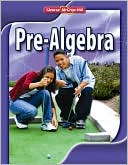
(A)
To compare the shaded portion of figure & write as a fraction. Write fraction as a percent & then compare that which has the greatest shaded part.
(A)
Answer to Problem 37PPS
Hence, the fraction
Explanation of Solution
Given:
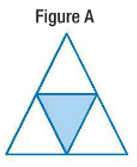
Total parts of the
Shaded parts of the triangle
Concept Used:
We use the concept of same whole fraction method.
For example,
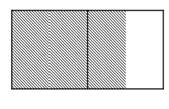
If each of the square is a “whole”, the shaded area represents the fraction
Calculation:
As per given information,
The given figure represents
Fraction representing shaded region of triangle
Now, convert the fraction to a decimal,
Then multiply by
Conclusion:
Thus, the fraction of given figure
(B)
To compare the shaded portion of figure & write as a fraction. Write fraction as a percent & then compare that which has the greatest shaded part
(B)
Answer to Problem 37PPS
Hence, the fraction is
Explanation of Solution
Given:
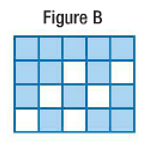
Total parts of the square
Shaded parts of the square
Concept Used:
We use the concept of same whole fraction method.
For example,
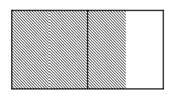
If each of the square is a “whole”, the shaded area represents the fraction
Calculation:
As per given information,
The given figure represents
Fraction representing shaded region of triangle
First reduce this fraction by dividing both the numerator and denominator by the Greatest Common Factor of
Then using long division method,
To convert the decimal into a percentage, multiply by
Conclusion:
Thus, the fraction of given figure is
(C)
To compare the shaded portion of figure & write as a fraction. Write fraction as a percent & then compare that which has the greatest shaded part
(C)
Answer to Problem 37PPS
Hence, the fraction is
Explanation of Solution
Given:
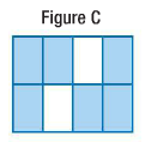
Total parts of the rectangle
Shaded parts of the rectangle
Concept Used:
We use the concept of same whole fraction method.
For example,
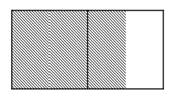
If each of the square is a “whole”, the shaded area represents the fraction
Calculation:
The given figure represents
Fraction representing shaded region of triangle
First reduce this fraction by dividing both the numerator and denominator by the Greatest Common Factor of
Then using long division method,
To convert the decimal into a percentage, multiply by
Conclusion:
Thus, the fraction of given figure is
Chapter 7 Solutions
Pre-Algebra, Student Edition
Additional Math Textbook Solutions
Basic Business Statistics, Student Value Edition
Calculus: Early Transcendentals (2nd Edition)
Elementary Statistics: Picturing the World (7th Edition)
Algebra and Trigonometry (6th Edition)
College Algebra (7th Edition)
- e). n! (n - 1)!arrow_forwardSuppose you flip a fair two-sided coin four times and record the result. a). List the sample space of this experiment. That is, list all possible outcomes that could occur when flipping a fair two-sided coin four total times. Assume the two sides of the coin are Heads (H) and Tails (T).arrow_forwarde). n! (n - 1)!arrow_forward
- Evaluate the following expression and show your work to support your calculations. a). 6! b). 4! 3!0! 7! c). 5!2! d). 5!2! e). n! (n - 1)!arrow_forwardAmy and Samiha have a hat that contains two playing cards, one ace and one king. They are playing a game where they randomly pick a card out of the hat four times, with replacement. Amy thinks that the probability of getting exactly two aces in four picks is equal to the probability of not getting exactly two aces in four picks. Samiha disagrees. She thinks that the probability of not getting exactly two aces is greater. The sample space of possible outcomes is listed below. A represents an ace, and K represents a king. Who is correct?arrow_forwardConsider the exponential function f(x) = 12x. Complete the sentences about the key features of the graph. The domain is all real numbers. The range is y> 0. The equation of the asymptote is y = 0 The y-intercept is 1arrow_forward
- The graph shows Alex's distance from home after biking for x hours. What is the average rate of change from -1 to 1 for the function? 4-2 о A. -2 О B. 2 О C. 1 O D. -1 ty 6 4 2 2 0 X 2 4arrow_forwardWrite 7. √49 using rational exponents. ○ A. 57 47 B. 7 O C. 47 ○ D. 74arrow_forwardCan you check If my short explantions make sense because I want to make sure that I describe this part accuratelyarrow_forward
 Algebra and Trigonometry (6th Edition)AlgebraISBN:9780134463216Author:Robert F. BlitzerPublisher:PEARSON
Algebra and Trigonometry (6th Edition)AlgebraISBN:9780134463216Author:Robert F. BlitzerPublisher:PEARSON Contemporary Abstract AlgebraAlgebraISBN:9781305657960Author:Joseph GallianPublisher:Cengage Learning
Contemporary Abstract AlgebraAlgebraISBN:9781305657960Author:Joseph GallianPublisher:Cengage Learning Linear Algebra: A Modern IntroductionAlgebraISBN:9781285463247Author:David PoolePublisher:Cengage Learning
Linear Algebra: A Modern IntroductionAlgebraISBN:9781285463247Author:David PoolePublisher:Cengage Learning Algebra And Trigonometry (11th Edition)AlgebraISBN:9780135163078Author:Michael SullivanPublisher:PEARSON
Algebra And Trigonometry (11th Edition)AlgebraISBN:9780135163078Author:Michael SullivanPublisher:PEARSON Introduction to Linear Algebra, Fifth EditionAlgebraISBN:9780980232776Author:Gilbert StrangPublisher:Wellesley-Cambridge Press
Introduction to Linear Algebra, Fifth EditionAlgebraISBN:9780980232776Author:Gilbert StrangPublisher:Wellesley-Cambridge Press College Algebra (Collegiate Math)AlgebraISBN:9780077836344Author:Julie Miller, Donna GerkenPublisher:McGraw-Hill Education
College Algebra (Collegiate Math)AlgebraISBN:9780077836344Author:Julie Miller, Donna GerkenPublisher:McGraw-Hill Education





